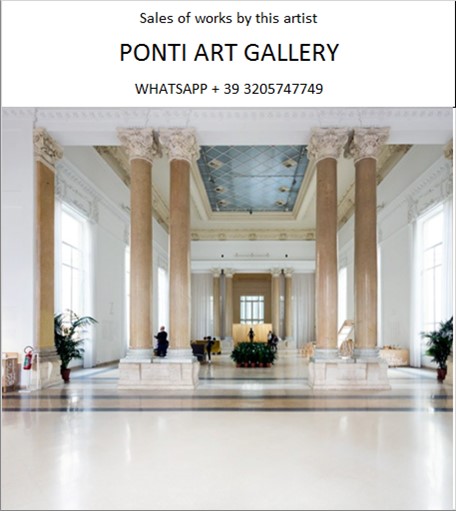Ponti Art Gallery is interested in buying and selling works
of art by this artist.

Marino Marini Biography
Marino Marini was an Italian sculptor, painter, and printmaker whose work is celebrated for its classical roots and modern sensibility. Born on February 27, 1901, in the Tuscan town of Pistoia, Italy, Marini was exposed to the rich cultural heritage of his homeland from an early age. His formative years were spent in Florence, where he enrolled in the Accademia di Belle Arti in 1917. There, he studied painting under Galileo Chini and sculpture with Domenico Trentacoste, honing his skills in both disciplines.
Marini's early artistic endeavors were primarily focused on painting and drawing, but by the 1920s, he had shifted his attention to sculpture, which would become his primary medium. His work was deeply influenced by Etruscan art and the sculpture of Arturo Martini, whom he succeeded as a professor at the Scuola d’Arte di Villa Reale in Monza, near Milan, in 1929. This position allowed him to influence a new generation of Italian sculptors and to further develop his own artistic language.
Throughout the 1930s, Marini traveled extensively between Italy, France, and Switzerland, forming friendships with other prominent artists of the time, including Alberto Giacometti, Germaine Richier, and Fritz Wotruba. His work during this period began to gain significant recognition, and he participated in numerous exhibitions, including the Venice Biennale and the Quadriennale di Roma, where he won first prize for sculpture in 1935.
In 1938, Marini married Mercedes Pedrazzini, affectionately known as Marina, who would be his companion for the rest of his life. The outbreak of World War II had a profound impact on Marini's work. In 1940, he accepted a professorship in sculpture at the Accademia di Belle Arti di Brera in Milan but was forced to flee to Switzerland in 1943 due to the war. His experiences during this time, particularly his exposure to the suffering and destruction caused by the conflict, deeply influenced his artistic output.
Marini's sculptures from this period began to reflect a sense of tension and dynamism, with his equestrian statues becoming particularly emblematic of his style. These works often depicted a horse and rider, with the rider struggling to maintain control, symbolizing the human condition and the existential struggle of man. His sensitivity to form and surface, combined with an inner tension in his figures, reflected both classical influences and the impact of contemporary events.
After the war, Marini returned to Milan and resumed his teaching position at the Brera Academy. His international reputation continued to grow, and he participated in the 'Twentieth-Century Italian Art' show at the Museum of Modern Art in New York City in 1944. His work was also exhibited at the Buchholz Gallery in New York, where he met influential artists such as Jean Arp, Max Beckmann, Alexander Calder, and Jacques Lipchitz.
Marini was awarded the Grand Prize for Sculpture at the Venice Biennale in 1952 and the Feltrinelli Prize at the Accademia dei Lincei in 1954. His monumental sculptures were installed in public spaces, including The Hague, and his work was featured in retrospectives in Zurich, Rome, and Japan.
In addition to sculpture, Marini returned to painting in the late 1940s, working in a colorful, abstract style. He also produced a significant body of graphic work, including etchings and lithographs. His paintings and prints, like his sculptures, often explored his recurring themes of the horse and rider, the female nude, and portrait busts.
Marini's legacy was cemented with the establishment of museums dedicated to his work. The Marino Marini Museum in Florence, housed in the former Church of San Pancrazio, was inaugurated in 1988, following a donation of his works to the city. The museum preserves a comprehensive collection of his sculptures, paintings, drawings, and engravings, showcasing the thematic and stylistic evolution of his career.
Marino Marini passed away on August 6, 1980, in Viareggio, Tuscany, Italy, leaving behind a body of work that continues to be celebrated for its unique blend of classical tradition and modern expression. His sculptures, in particular, stand as powerful symbols of the human experience, reflecting both the strength and vulnerability of mankind. Marini's influence on the art world endures, and his works are included in the collections of major museums around the globe, serving as a testament to his enduring impact on modern art.
Marino Marini Quotes and Sales
of Works
Ponti Art Gallery selects and deals with paintings by the
artist. Upon request, we provide free estimates and
evaluations, communicate prices, quotations, and current
market values.
If you are interested in BUYING or SELLING works by the
artist, contact us immediately.
If you wish to sell or receive an evaluation of the
works:
Send us a frontal photo of the painting, one of the back,
and one of the signature. Also, indicate the dimensions of
the work. Inform us about the purchase origin of the work
and any kind of available documentation (purchase
receipts, certificates of authenticity, publications). One
of our operators will respond to you on the same day. We
guarantee maximum confidentiality and extreme
professionalism.
If you wish to purchase works by the painter: Contact us
and let us know your request. We will inform you about the
available works. We also offer the possibility to
subscribe to our NEWSLETTER, through which you will be
informed at the beginning of each month about the latest
acquisitions of the art gallery.
You can send us pictures of the work:
